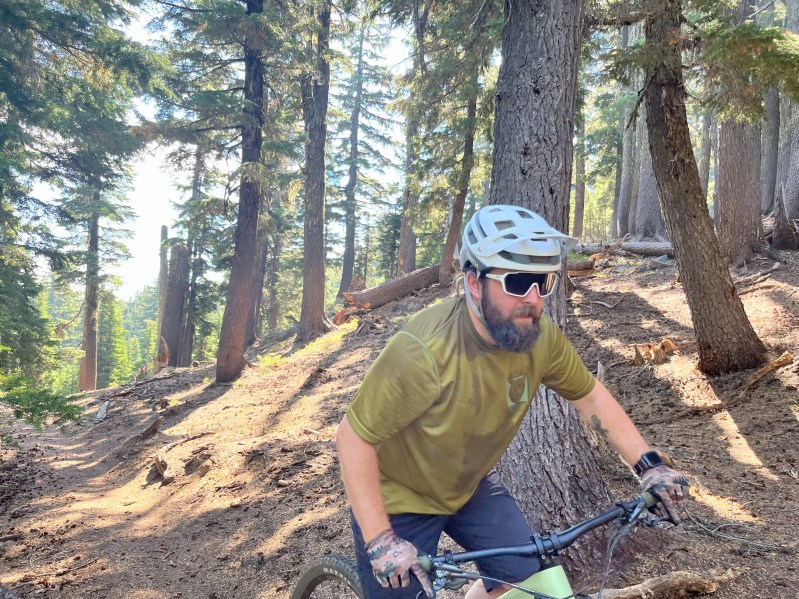
Buying a new mountain bike can seem like an overwhelming task. Even knowing what types of bikes there are can feel like learning a foreign language.
Once you’ve narrowed down what type of mountain bike you want to get, you then have to choose between the hundreds of options in that category. The bottom line is that mountain biking is full of lots and lots of decisions.
And what mountain bike to get isn’t the only thing you need to consider What about mountain biking gear? You’ll need a good mountain bike helmet.
What about mountain bike shoes and other apparel? Are they completely necessary? Do they have to be mountain bike-specific? Let’s look at many of the options you may be facing to help you make the most informed decisions.

Common mountain bike options
Who would have thought that mountain biking would have so many choices when it came to the mountain bike itself? From frame material, wheel size, suspension platforms, and more, not having all the information can leave you wishing you’d made a different decision.
- Regular or electric mountain bike? An electric mountain bike (E-MTB) is certainly an appealing choice. Once the subject of much criticism, we have seen more and more riders turning to E-MTBs to put in extra laps. The pedal assist makes long climbs easier, allowing for longer descents. What could be better?
But, depending on where you live and ride, you may find your trail options are limited. Many mountain bike trails are on public lands, often managed by the Forest Service. Most Forest Service trails aren’t open to E-MTBs. Make some calls before you buy.
- Buy a new or used mountain bike? Buying a used bike is a great way to save some money. It’s not hard to find one that has been well taken care of and is less than a year old.
However, mountain bike warranties typically are only for the original owner of the mountain bike. If you buy used, don’t expect the bike manufacturer to take care of you if the frame brakes.
- Buy an entry-level mountain bike or higher-end? Maybe you have heard the phrase, “Buy once, cry once”? This certainly applies to mountain bikes. Simply put, higher-end components on a mountain bike will perform better and last longer, but will come with a higher price tag.
How often do you ride? A couple of times a month? You can probably get away with a more entry-level build on a mountain bike. If you are riding several times a week, you’ll likely save money by buying a higher-end bike upfront and not having to upgrade.
- Carbon fiber or aluminum frame? Aluminum was the material of choice for mountain bike frames for quite a while. It was strong but heavy. Carbon fiber came along, offering a much lighter material for frames. The trade-off for carbon fiber, however, is that it was known to break and was incredibly expensive.
Fast forward to today and the mountain bike industry has come a long way in frame design and manufacturing. Aluminum has gotten significantly lighter and carbon has much more reliable. Carbon fiber’s price has dropped as well, although it is still a bit more than aluminum. The bottom line is that both materials are great options for frames.
- 29in wheels or 27.5in? The evolution of mountain biking is that the original 26-inch wheel gave way to the 27.5-inch, which would eventually be overtaken by the 29-inch wheel. If 29 is the new trend, go with that, right?
It depends on what you are riding. If you are riding a lot of jumps or perhaps bike park laps, a smaller 27.5-wheel will probably work better. For all other trail use, go 29-inch. It is the trend, after all.
- Full suspension or hardtail? A hardtail, meaning that the mountain bike only has front suspension, is going to be cheaper than a full suspension bike. Quite often the higher-end hardtails will be the same price as entry-level full-suspension mountain bikes. The trade-off, however, is that it will be less capable.
Once again, think about what you will be riding most. Is it steep and chunky downhill with big drops? You might spring for the full suspension. Is it relatively mellow flow trails or cross-country? Save your money and get a hardtail.

Common mountain biking gear options
You don’t need mountain biking’s latest and greatest to be able to enjoy the trails. However, having activity-specific equipment can certainly enhance your ride.
- Mountain bike shoes: flats or clips? I do recommend getting shoes made for mountain biking. You’ll have a greater grip, greater protection, and a stiffer sole. But, should you get shoes that clip into your pedals or flats?
I would recommend starting with flats. It is important to learn some of the basic skills on flat pedals rather than clips. Having your feet literally attached to the pedals can allow you to form poor habits while you’re learning. Ride flats now, try clips later.
- Mountain bike apparel or athletic clothing? It’s true, you do not need mountain bike shorts to ride your mountain bike. Any pair of gym shorts will suffice. However, you may find that mountain biking apparel, although a bit more expensive, is perfect for, well, mountain biking.
Shorts, pants, jerseys, and jackets that are made for mountain biking are built with the sport in mind. Bottoms are designed with sitting on a mountain bike seat in mind. Tops are sweat-wicking. And all quality mountain bike apparel is intended to take some abuse.
- Hip-pack or backpack? Of course, this comes down to personal preference but, if you ask me, I’d go with a hip-pack all day. A backpack ends up being a sweat trap on your back.
Hip-packs have also grown to the point where they are nearly the size of a backpack you might wear mountain biking. And, we all know, a sweaty lower back is better than a sweaty entire back.
The most important aspect of mountain biking is having a blast. This can be done on a hardtail or a full suspension, a carbon or aluminum frame. You can have a blast in mountain bike-specific apparel or just jeans and a t-shirt. Have fun, be safe, and do your thing.
Besides, if you catch the mountain bike bug like I have, you will end up trying all of these options anyway.



